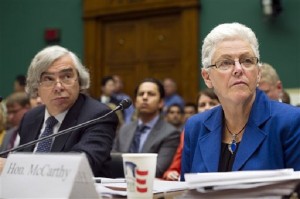
EPA Administrator Gina McCarthy, right, and Energy Secretary Ernest Moniz testify before the House Subcommittee on Energy and Power on Capitol Hill, in Washington, Wednesday, Sept. 18, 2013. The energy panel meeting Wednesday comes just days before a deadline for the Environmental Protection Agency to release a revised proposal setting the first-ever limits on carbon dioxide from newly built power plants. AP
WASHINGTON—The Obama administration is pressing ahead with tough requirements to limit carbon pollution from new coal-fired power plants, moving to impose for the first time strict limits on the pollution blamed for global warming.
The proposal would help reshape where Americans get electricity, moving away from coal and toward cleaner sources of energy. It’s a key step in President Barack Obama’s plans to address climate change because it would help end what he called “the limitless dumping of carbon pollution” from power plants.
The proposed rule eventually would force the government to limit emissions from existing power plants, which account for a third of all U.S. greenhouse gas emissions. Obama has given the Environmental Protection Agency until next summer to propose those regulations.
EPA administrator Gina McCarthy said in a speech Friday to announce the proposal that, rather than damage industry, the proposed regulations would help the industry to grow.
McCarthy pressed her case by linking global warming to a host of environmental problems, from severe weather to disease to worsening other types of air pollution.
“We know this is not just about melting glaciers,” McCarthy said. “Climate change—caused by carbon pollution—is one of the most significant public health threats of our time. That’s why EPA has been called to action.”
To meet the new standard, new coal-fired power plants would need to install expensive technology to capture carbon dioxide and bury it underground. No coal-fired power plant has done that yet, in large part because of the cost.
Coal, which is already struggling to compete with cheap natural gas, accounts for 40 percent of U.S. electricity, a share that was already shrinking. And natural gas would need no additional pollution controls to comply.
The EPA already has issued rules aimed at curbing global warming pollution from automobiles and the largest industrial sources.